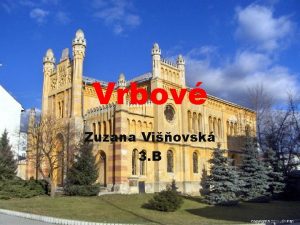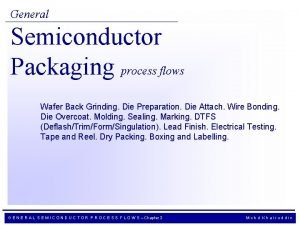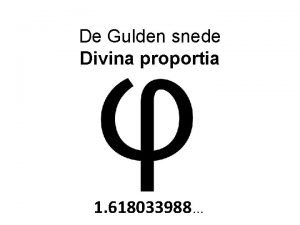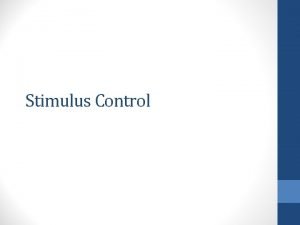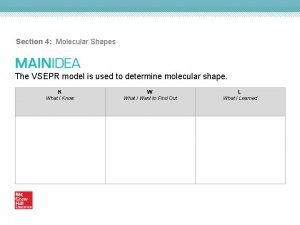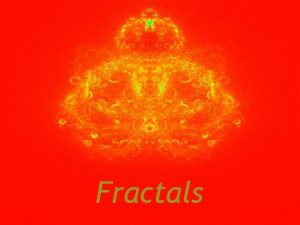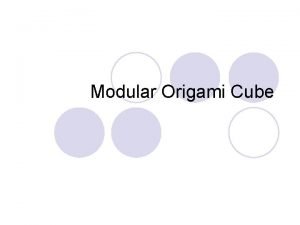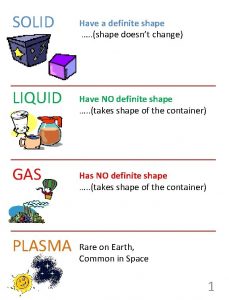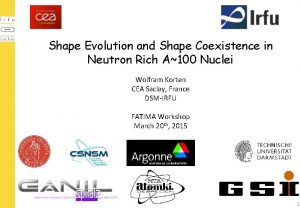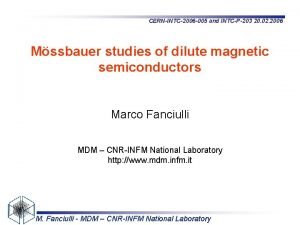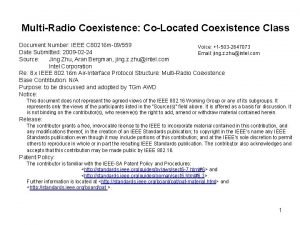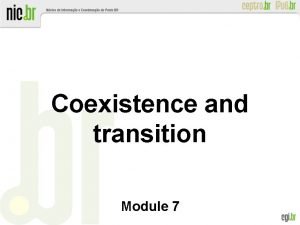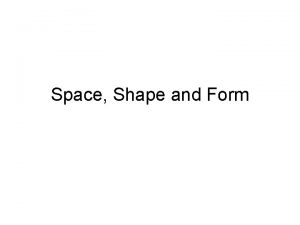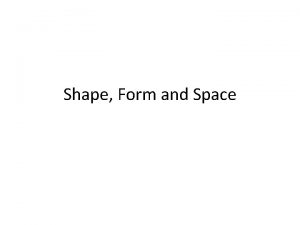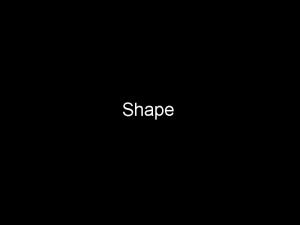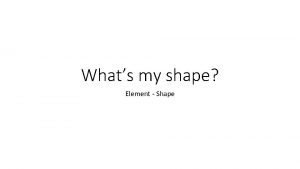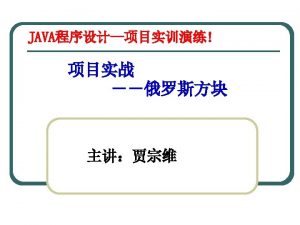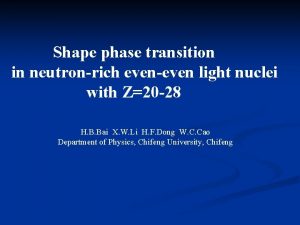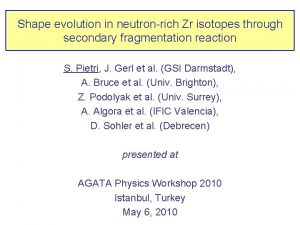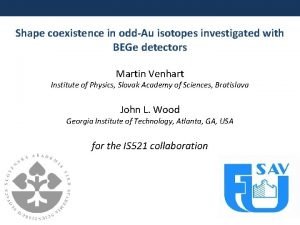INTCP216 CERNINTC2006 033 Shape coexistence in neutronrich Sr



















- Slides: 19

INTC-P-216 CERN-INTC-2006 -033 Shape coexistence in neutron-rich Sr isotopes: Coulomb excitation of 96 Sr Emmanuel Clément CERN-PH, Geneva Andréas Görgen CEA-Saclay DAPNIA/SPh. N France

Shapes of exotic nuclei Oblate Prolate Quadrupole deformation of the nuclear ground states M. Girod, CEA Ø deformed nuclei B(E 2) Ø oblate and prolate shapes static moment Ø prolate, oblate or spherical states within small energy range shape coexistence

n-rich Sr and Zr isotopes All theoretical calculations predict a sudden onset of quadrupole deformation at the neutron number N=60 … but differ for deformation parameter and excitation energy HFB Gogny D 1 S E [Me. V] M. Girod CEA Bruyères-le-Châtel 96 Sr is a transitional nucleus Both deformations should coexist at low energy Shape coexistence between highly deformed and quasi-spherical shapes Important constraints for modern nuclear structure theories : Predicted values of b 2 E (0+2), r²(E 0), B(E 2), Q 0 … Mixing of wave function GCM

Evidence for shape coexistence in Sr and Zr The first evidence is the energy of the 2+1 state N=58 |b| <<1 : Quasi-spherical |b| >0 : deformed state

Evidence for shape coexistence in Sr Level scheme established by spectroscopic experiments Ground state band N=58 N=60 t = 7(4) ps Nearly spherical ground state Highly deformed rotational band b ≈ 0. 4

Evidence for shape coexistence in Sr Excited configuration N=58 N=60 r(E 0)² = 53 m. u. r(E 0)² = 180 m. u. r(E 0)² is directly linked to deformation and mixing configuration

Evidence for shape coexistence in Sr N=58 N=60 The highly deformed band 0+3 2+3 4+2 becomes the ground state band in 98 Sr

Evidence for shape coexistence in Sr Recent results : C. Y. Wu et al. PRC 70 (2004) W. Urban et al Nucl. Phys. A 689 (2001) Lifetime compatible with b = 0. 25 N=58 N=60 The onset of deformation around N=58 is maybe more gradual

Evidence for shape coexistence in Sr Lifetimes compatible with b = 0. 25 N=58 b ≈ 0. 4 N=60 The measure of transition strength and intrinsic quadrupole moments is essential to understand the complex shape coexistence in Sr isotopes Coulomb excitation

Experimental details First Sr beam at REX-ISOLDE need new development Molecular beam has shown the efficiency of this technique in term of purity and intensity… see 70 Se case (A. Hurst et al. Isolde workshop and users meeting 2005/2006) Separator The proposed Se beam development has strong synergies : • Ba beam for IS 411, Krücken et al. • 78 Sr D. Bandyopadhyay et al. this INTC 96 Rb UCx Target 5. 7 106 96 Sr/m. C Trap Molecular extraction 96 Sr 19 F Separator n-converter Proton beam 96 Sr REX-beam 2. 9 Me. V/u 105 pps for 2 m. C EBIS Slow extraction PSB 115 In

MINIBALL SET UP Classical set up composed by : The 8 clusters of MINIBALL Stripped silicon detector for particles detection (Doppler correction and differential cross section) REX beam 120 Sn Coulomb excitation on 120 Sn target : Compromise between cinematic andcoulex cross section Coulex normalisation possible through the Sn gamma line Cross section between 29. 5 and 147. 5 deg incenter of mass (differential cross section)

Coulomb excitation cross section Improve the B(E 2) 0+1 ->2+1: 7(4) ps Extract the diagonal matrix element Establish the properties of the ground state band

Coulomb excitation cross section Establish the set of transitional matrix elements at low spins Extract diagonal matrix elements Understand the structure at low spin of the deformed configuration(s)

Coulomb excitation analysis : GOSIA* *D. Cline, C. Y. Wu, T. Czosnyka; Univ. of Rochester Ø yields as function of scattering angle: differential cross section Ø Least squares fit of matrix elements (transitional and diagonal) Ø Experimental spectroscopic data Lifetimes Branching ratios < 9 ps 9. 7(1. 4) ns 167(17) ps 7(4)ps

Coulomb excitation analysis : GOSIA* *D. Cline, C. Y. Wu, T. Czosnyka; Univ. of Rochester Ø yields as function of scattering angle: differential cross section Ø Least squares fit of matrix elements (transitional and diagonal) Ø Experimental spectroscopic data Lifetimes Branching ratios Spectroscopic data limit the number of degrees of freedom < 9 ps 9. 7(1. 4) ns 167(17) ps 7(4)ps

Conclusion Coulomb excitation at low energy offers an unique opportunity to understand the complex scenario of shape coexistence in Sr isotopes Improvement of the B(E 2, 2+1 0+1) value Measure of the B(E 2) related to the 0+2, 3 and 2+2, 3 states Measure of the diagonal matrix element of the 2+1 state Measure of the diagonal matrix elements of the 2+2 and 2+3 states Precise comparisons with HFB+GCM calculations will be undertaken (P. H Heenen, M. Bender, … ) Requested beam time : 21 Shifts of radioactive beam 3 Shifts for setup (stable beam)

Collaboration E. Clément, J. Cederkäll, P. Delahaye, L. Fraile, F. Wenander, J. Van de Walle, D. Voulot, PH Department, CERN, Geneva, Switzerland A. Görgen, C. Dossat, W. Korten, J. Ljungvall, A. Obertelli, Ch. Theisen, M. Zielinska, DAPNIA/SPh. N, CEA Saclay, France T. Czosnyka, J. Iwanicki, J. Kownacki, P. Napiorkowski, K. Wrzosek, HIL, Warsaw, Poland P. Van Duppen, T. Cocolios, M. Huyse, O. Ivanov, M. Sawicka, I. Stefanescu, IKS Leuven, Belgium S. Franchoo, IPN Orsay, France F. Dayras, G. Georgiev, CSNSM Orsay, France A. Ekström, Department of Physics, Lund University, Sweden M. Guttormsen, A. C. Larsen, S. Siem, N. U. H. Syed , Department of Physics, University of Oslo, Norway P. A. Butler, A. Petts, Oliver Lodge Laboratory, University of Liverpool, UK, D. G. Jenkins, Department of Physics, University of York, UK, V. Bildstein, R. Gernhäuser, T. Kröll, R. Krücken, TU München, Germany P. Reiter, N. Warr , IKP Köln, Germany

96 Sr – 98 Sr

Coulomb excitation and reorientation effect 1 er order: 2 nd order: 2+ 2+ a(1) a(2) 0+ 0+ d s __ Reorientation effect = d. Wi f d s. Ruth __ d. W B(E 2) Pi f Q 0 Example: differential Coulex cross section from 74 Kr SPIRAL experiment: distinguish between prolate and oblate shapes I(4+)/I(2+)
 Zs vrbov
Zs vrbov Semiconductor packaging process flow
Semiconductor packaging process flow Divina proportia
Divina proportia Coexistence
Coexistence Personal archive migration
Personal archive migration A peaceful revolution apush
A peaceful revolution apush Bittitan coexistence
Bittitan coexistence The coexistence of good and evil
The coexistence of good and evil Shape matching and object recognition using shape contexts
Shape matching and object recognition using shape contexts Template matching
Template matching Airfoil nomenclature
Airfoil nomenclature Discrimination stimuli
Discrimination stimuli Phosphorus trihydride shape
Phosphorus trihydride shape Area of koch snowflake
Area of koch snowflake What shape is this
What shape is this Floating red markers are called nuns what shape are nuns
Floating red markers are called nuns what shape are nuns Weakness of bohr's atomic model
Weakness of bohr's atomic model Diamante poem rubric
Diamante poem rubric Axillary tail
Axillary tail Solid liquid gas plasma
Solid liquid gas plasma
